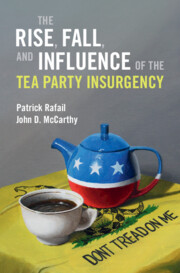
-
Select format
-
- Publisher:
- Cambridge University Press
- Publication date:
- December 2023
- December 2023
- ISBN:
- 9781009423724
- 9781009423779
- 9781009423731
- Dimensions:
- (228 x 152 mm)
- Weight & Pages:
- 0.52kg, 266 Pages
- Dimensions:
- (228 x 152 mm)
- Weight & Pages:
- 0.4kg, 266 Pages
- Subjects:
- Area Studies, Politics: General Interest, American Studies, Sociology: General Interest, American Government, Politics and Policy, Political Sociology, Politics and International Relations, Sociology
You may already have access via personal or institutional login- Subjects:
- Area Studies, Politics: General Interest, American Studies, Sociology: General Interest, American Government, Politics and Policy, Political Sociology, Politics and International Relations, Sociology
Book description
Emerging in 2009, the Tea Party movement had an immediate and profound impact on American politics and society. This book draws on a decade's worth of original, extensive data collection to understand why the Tea Party emerged, where it was active, and why it disappeared so quickly. Patrick Rafail and John McCarthy link the Tea Party's rise to prominence following the economic collapse that came to be known as the Great Recession. Paying special attention to the importance of space and time in shaping the Tea Party's activities, Rafail and McCarthy identify and explain the movement's disappearance from the political stage. Even though grassroots Tea Party activism largely ceased by 2014, they demonstrate the movement's effect on the Republican Party and American democracy that continues today.
Reviews
‘This book is carefully researched and uses a wide variety of data sources to support the authors’ arguments, providing a treasure trove of interesting new approaches to studying political movements. … Recommended.’
R. J. Gelm Source: CHOICE
‘Rafail and McCarthy’s book employs a variety of data sources and research methods to offer the most thorough analysis of the Tea Party to date … The vast amount of data and the authors' application of a diverse set of methods to understand one of the quintessential movements of the twenty-first century make it an essential read for anyone hoping to understand the broader field of social movements.’
Christopher Stout Source: Mobilization: An International Quarterly
Contents
-
1 - The Tea Party
pp 1-17 - An Insurgent Social Movement
-
-
- You have access
- HTML
- Export citation
-
Metrics
Altmetric attention score
Full text views
Full text views help Loading metrics...
Loading metrics...
* Views captured on Cambridge Core between #date#. This data will be updated every 24 hours.
Usage data cannot currently be displayed.
Accessibility standard: Unknown
Why this information is here
This section outlines the accessibility features of this content - including support for screen readers, full keyboard navigation and high-contrast display options. This may not be relevant for you.
Accessibility Information
Accessibility compliance for the PDF of this book is currently unknown and may be updated in the future.


